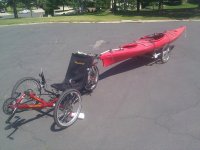I generally agree with being able to keep the trailer narrow, but if like me you generally use roads rather than bike paths for large cargo, wider can sometimes be better (in that cars tend to be more likely to give me the lane if I am already taking up more of it).

If you need larger diameter wheels for whatever reason (like in my case to help with ride quality and ability to pull the loaded trailer over bad pavement, curbs, etc, that smaller diameter wheels would cause me problems with (or altogether prevent me from going over/thru)), but also need it to be low-slung, you could build the trailer like my new Mk IV flatbed kennel trailer linked in my signature.
The catch with a long, but low, trailer is that anything other than a flat road can be problematic, unless there are some sort of wheels or casters at the end of the trailer away from the main wheels to prevent the frame from dragging on the ground or curb, etc. I've been pondering ways to deal with that for my trailer, becuase I'm still working out a larger/longer (but low) version of it for carrying building materials, furniture, etc., instead of just St Bernards.

Even at it's relatively short length, it still has that trouble with curbs/driveways sometimes.
FluxZoom said:
My goal is to replace the need to ever rent a truck, car or trailer to carry large and heavy loads. This entails being able to carry things like long beams of steel, lumber and even sheets of drywall. Likely a foolish goal
I don't see why it'd be foolish; there's a guy near Copenhagen with a pedal-only longbike (bakfiet type) that can carry full sheets of plywood, full-length wood beams, etc.
There's at least one trailer larger than any of mine here on ES posted in the last few months, made to carry at least two full bikes on it; I forget whose it is though. :/
I have a thread titled "Barkfiet" (something or other) that is about my Loooooooongbike I'd like to someday build (just for the heck of it if ntohing else), though by the time I do get aroud to it it'll probably be a leaning trike with a narrow double-wheel front end just enough to hold it up when stopped/loading.
but I suspect it's one I can achieve with careful planning and clever approaches combined with a modular telescoping trailer design.
I have some ideas in that telescoping stuff, in that Barkfiet thread.
With that in mind, I am not so sure about the idea of the placement of a single driving wheel in a two wheeled trailer, I suspect the driving wheel will be pretty much far from the center of a trike it is pushing. Meaning chances are slanted or dragging wheels might be an issue to consider.
Honestly, I think that given the power levels you're after, it's going to be cheaper *and* easier to just use two powered wheels on it, one on each side.
I doubt the problems in operating it with unbalanced pushing would be very bad, I think you could learn to deal with that with just a little practice in the various sitautions you'd encoutner it in, as I have on my trikes.
But it'll be just be cheaper to go with two small motors and controllers than one big one.
It'll also be "safer", because you'll have redundancy--if one fails for any reason, you stil lhave half your power to be able to push along, rather than having ot pedal your entire load.

That's really why I have two on the trike, and two on the bike--I'm not really capable of pedalling the kind of loads I have to move around (or the vehicles I use to move them!).

So if something failed, I'd be totally screwed if I had no backup. A few months back, I proved that to myself the hard way, when I ran out of battery power on the trike a few miles from home; had to veerrry slooowwwly pedal it, with rest stops, till I got to where I could charge it a bit (and rest before I passed out from the pain and the effort), at the breakroom at work that hapepend to be on my way back home.
As for the other points, about the problems with pushing one-sided vs length and load, you'd really ahve to try it out to see...but I'd persoanlly just avoid the problem and do a motor on each side just for the reasons listed above.



